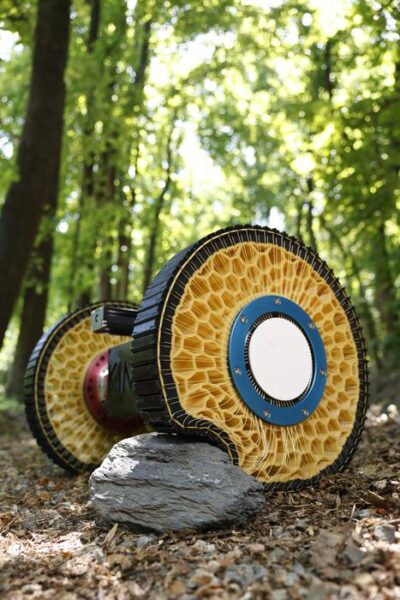The Korea Institute of Machinery and Materials (KIMM) has unveiled a groundbreaking wheel technology capable of adjusting its stiffness in real-time, allowing vehicles to navigate over rough terrains like rocks and stairs with ease. This innovation, inspired by the surface tension of liquid droplets, promises to revolutionize mobility systems across various applications.
The Science Behind the Morphing Wheel
The new morphing wheel, developed by Principal Researcher Sung-Hyuk Song and Head of the Advanced Robotics Research Center Dong Il Park, utilizes a smart chain block system. This system mimics the surface tension of a liquid droplet, where the wheel’s rigidity can be altered by tightening or loosening wire spokes connected to the wheel’s hub. “The wheel can operate as a rigid, circular wheel in a regular driving mode and then switch to a soft, deformable state when rolling over obstacles,” explains Song, highlighting the wheel’s adaptability.
Traditional wheels, even those with flexible structures like non-pneumatic tires, continuously deform, which affects driving efficiency and stability. In contrast, KIMM’s wheel maintains a rigid state for flat surfaces and softens for obstacle navigation, enhancing both performance and safety.
Applications and Future Prospects
This technology has already been successfully applied to a two-wheeled wheelchair, demonstrating its capability to navigate over 18cm-high stairs and rough terrains. The wheelchair’s ability to change wheel stiffness allows for stable movement and maneuverability in tight spaces. Moreover, when integrated into a four-wheeled system, the wheel can overcome obstacles 1.3 times its radius, showcasing its versatility.
Dong Il Park envisions broad applications, stating, “This new technology… can help to overcome the limitations of conventional mechanical devices such as leg-type robots and wheel clusters for overcoming obstacles.” This suggests potential uses in personal mobility devices, robotics, and even specialized vehicles designed for extreme environments.
Why it Matters: The morphing wheel technology addresses a fundamental challenge in mobility: efficiently navigating diverse terrains. By offering a solution that adapts in real-time, it could significantly improve the quality of life for individuals with mobility impairments, enhance robotic exploration capabilities, and potentially transform transportation systems.
Quiz:
- How does the morphing wheel change its stiffness, and what inspired this technology?
- What are some of the limitations of traditional flexible wheel technologies compared to KIMM’s new wheel?
- In what practical scenarios could the variable-stiffness wheel be particularly beneficial?
Answer Key:
- Mechanism and Inspiration:
The morphing wheel changes its stiffness by adjusting the tension of wire spokes connected to smart chain blocks, inspired by how surface tension in liquid droplets works to maintain or change shape. - Limitations of Traditional vs. New Technology:
Traditional flexible wheels like non-pneumatic tires deform continuously, leading to reduced efficiency, stability, and increased noise on flat surfaces. KIMM’s wheel can switch between rigid and soft states, optimizing performance for both flat and rough terrains. - Practical Applications:
The technology would be particularly beneficial in scenarios requiring adaptability to terrain changes, such as wheelchairs navigating urban environments, robotic exploration in uneven landscapes, or specialized vehicles for rescue and military operations.
If our reporting has informed or inspired you, please consider making a donation. Every contribution, no matter the size, empowers us to continue delivering accurate, engaging, and trustworthy science and medical news. Independent journalism requires time, effort, and resources—your support ensures we can keep uncovering the stories that matter most to you.
Join us in making knowledge accessible and impactful. Thank you for standing with us!

